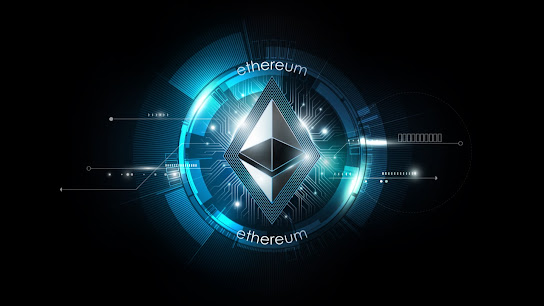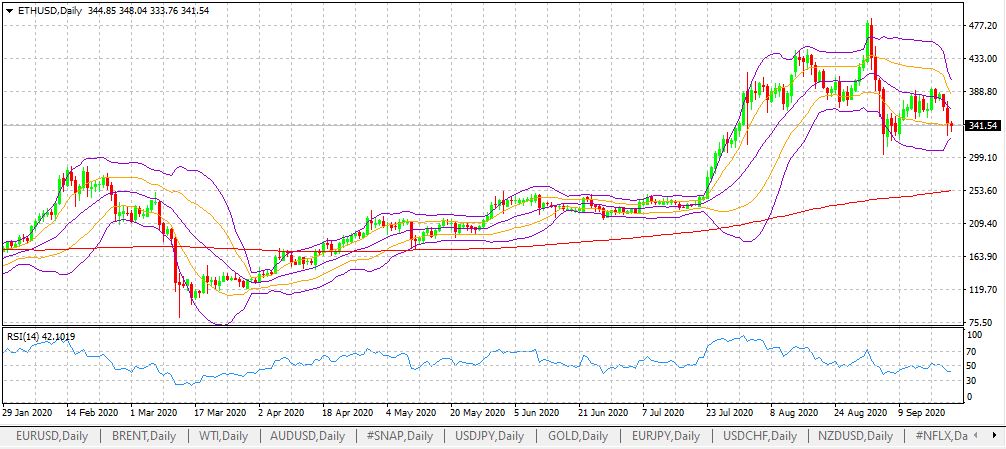latriom or Ethereum and symbolized by ( the ETH ) is a software platform open source technology based on blockchain, which enables developers to build applications and issuing decentralized. It's actually more than just a digital currency, it's just one part of the Ethereum offering. So, is it the same as Bitcoin? Well, the answer is yes and no!

Ethereum and Bitcoin both share the fact that they were built using public, distributed network technology - known as blockchain or cascading blocks - but this is where the similarity ends. Bitcoin introduces a single app - a peer-to-peer digital currency system that allows online payments. It is actually a currency in its most basic form.
While Bitcoin uses blockchain technology to track who owns Bitcoin, Ethereum uses the blockchain as a platform to run almost any decentralized application. Bloomberg once described it as "a common program that can be used by everyone but is resistant to manipulation and monopoly." Hence the possibilities are truly endless!
Where did Ethereum come from and who invented it?
Ethereum was originally created by Vitalik Buterin , a cryptocurrency researcher and programmer who previously worked on Bitcoin in 2013. An online crowdfunding crowd held in 2014 formed the main part of the platform's funding. The system went into operation on July 30, 2015, and was crammed with 11.5 million “coins” of Ethereum ready for a trial.
How does Ethereum work?
In Ethereum cascading blocks , unlike from Bitcoin "mining", users earn an "Ether coin" which is a type of digital currency that fuels the Ethereum network. In addition to being a tradable cryptocurrency, Ethereum is also used by developers to pay for services on the Ethereum network.
Trade Ethereum in risk-free conditions
The best way to practice trading with cryptocurrency CFDs is to open a free demo trading account. Both beginners and advanced traders can benefit from a demo account, as it provides the entire live trading experience, with all the analysis and real-time information from the live markets, but without putting your capital at risk. Click on the banner below to open a free demo trading account today!
Explanation of Ethereum and Blockchain
You might still have a question: But what is a blockchain? Blockchain technology is a decentralized, public repository for all Bitcoin transactions mainly and cryptocurrencies such as Ethereum that have been executed in the past. A certain number of digital currency transactions make up one database unit, known as a "block," and each block stores information about the previous block. Additionally, each transaction stores information about its previous transaction. In this way, blockchain technology enables complete transparency in all online digital currency transactions.
The blockchain infrastructure in Bitcoin has introduced a revolutionary way to store financial data that anyone can access, and it is completely transparent to you, and it is developed using open source code, and does not belong to any person or entity. Instead, blockchain system maintenance is performed using the collective power of millions of computers that verify and confirm transactions, and then add them to the "block". Collectively verified transactions cannot be modified or deleted, therefore all Bitcoin and cryptocurrency operations that use this principle are final and indisputable.
In this sense, it is somewhat similar to Wikipedia. Each entry is uploaded and edited, the information contained therein is not controlled by anyone. As for the Ethereum currency, the blockchain acts as a kind of database, which tracks all transactions and operations that take place on the Ethereum network.
How do I use Ethereum?
The currency of Ethereum is increasingly being used to pay for certain goods and services online within the Ethereum network.
The list is constantly expanding, here are some examples of how you can spend Ethereum, including:
- Video Games
- Gift cards
- Travel
- Tipping
- Donations
- Electronic stores
Ethereum price against the US dollar
Since the inception of Ethereum in 2015, the digital currency has shown slow progress in its first year. 2017 was a completely different story. The digital currency started the year at a low level of 7.76 dollars, and by the end of the year the Ethereum currency exceeded 700 dollars, an increase of more than 9000%! Unlike Bitcoin, which hit an all-time high in 2021, Ether carried some bullish momentum in early 2018, eventually peaking above $ 1,300 in mid-January.
As with other cryptocurrencies, though, 2018 has proven to be a test year as a whole for Ethereum, as its price has gradually declined since that point, stabilizing at roughly $ 130 by the end of the year.
As for the year 2019, the Ethereum currency against the US dollar has been in an upward movement since the beginning of the year until it reached in June at $ 361 per one Ether currency. And it began to decline until the end of the year, reaching levels close to the January opening price of $ 139. Ethereum closed just $ 12 higher than its opening price at the beginning of the year at $ 151.
In 2020, the price of Ethereum began to rise again, in the same way as it did in 2019, and it continued to rise until the beginning of September, to achieve an increase of 222.5%! As it reached 487 dollars.
Why did the price of Ethereum move so fast?
What was the reason for the rapid bullishness in 2017? Well, the answer is both simple and complex, and it comes with increased investor awareness. As the public became more acquainted with cryptocurrencies like Ether and Bitcoin, interest increased as a result. The case of Ethereum coin is much more interesting. It had such a huge price spike almost exclusively because it resembles Bitcoin, and investors wanted to jump the boat early when prices were somewhat low.
Naturally, as with all markets, bearishness can occur as well. Just as the impressive gains for 2017 were driven by the kind of multiplier effect of higher prices that drove investor demand, which in turn led to higher prices, increasing demand, once the market started selling in 2018, we saw the opposite. The price correction annoyed investor demand, which led to more selling, lowering prices and thus curbing demand.
Is Ethereum Safe? What are the risks of trading Ethereum?
Ethereum is as safe as any other currency market - however, there can be moments of high volatility, which increases the eagerness of traders of course. It is always recommended that traders use the Volatility Protection settings , as they can help reduce risks while trading. Traders are also encouraged to learn how to manage risk effectively, as implementing this in their trading interactions can be of great help in terms of reducing the risks involved in trades.
Ethereum price analysis in 2020
Like other cryptocurrencies, Ethereum started 2020, up as much as the previous year. Although the price continued to rise until September, it started to drop from the annual peak since early in the month, as we can see from the chart below.
Past performance is not necessarily an indicator of future performance.
The decrease in the price in September, which reached the price of Ethereum to $ 302, which is about 39% lower than its annual highs at the beginning of the month, and from that point after it broke through the lower band of the Bollinger Bands indicator and with the closing of the green candle the next day, the price started Alatriom to rise again and is still Attdaol over a 200 - period moving average, which shows that prices are still in a trend upward.
Moreover, we can see the trading range very similar to the drop that occurred between February 14th to March 13th. Ethereum is now trying to recover to a higher level alongside the wider cryptocurrency market, after the second largest cryptocurrency found strong support from the $ 310 level.
Ethereum price analysis shows that the cryptocurrency has an increasing bullish tendency as the price trades above $ 350. But we will always bear in mind the possibility of a new wave of Coronavirus, which may lead to a decline in global markets again.
Given some historical context for these price levels, the value of Ethereum has varied since its inception less than five years ago, as evidenced by the following price chart:
Past performance is not necessarily an indicator of future performance.
Like Bitcoin and other digital currencies, Ether provides an alternative to fiat currency. The support for Ethereum, though, is the ability to develop applications using smart contracts on the Ethereum blockchain platform. Looking ahead, to whatever applications you might launch, of course, is uncertain.
As Ethereum's own site says , the platform's global infrastructure allows developers to "store debt records, transfer funds according to instructions that have been provided for a long time in the past (such as a will or a future contract) and many other things that have not yet been invented, all of that." Without the risk of a middleman or counterparty. "
read also : What are digital currencies?




Comments
Post a Comment